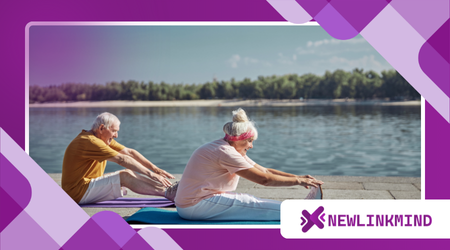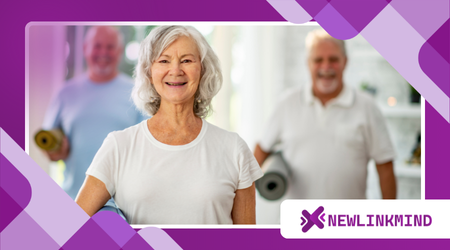A Beginner’s Guide to Yoga for Seniors

Anúncios
Beginner’s Guide to Yoga for Seniors. Yoga, an ancient practice connecting mind, body, and spirit, offers a gentle yet powerful path to wellness, especially for older adults.
It’s a journey of self-discovery, not a competition. This guide explores how yoga can transform your life, offering flexibility, balance, and inner peace, no matter your age or physical condition.
Why Yoga is an Ideal Practice for Seniors
As we age, our bodies naturally lose some flexibility and strength. Our joints can become stiff, and our balance may waver.
Yoga directly addresses these changes with its mindful movements and controlled breathing.
It’s not about contorting your body into impossible poses; it’s about honoring your body’s current abilities.
Anúncios
A consistent practice builds resilience, reducing the risk of falls and keeping your body and mind agile.
Imagine your body as a garden. Without regular care, weeds can take over, and the soil can become hard.
Yoga is like tending to that garden, a gentle cultivation of your physical and mental landscape. It keeps the pathways clear and the spirit vibrant.
Anúncios
The Amazing Benefits of Senior Yoga
The benefits of yoga extend far beyond the physical. Regular practice can improve circulation, lower blood pressure, and enhance sleep quality.
It’s also a powerful tool for stress reduction. The focused breathwork, or pranayama, helps calm the nervous system, reducing anxiety and promoting a sense of well-being.
Read more: Yoga for Seniors: Stretching Safely at Every Stage of Life
Studies have shown a strong link between yoga and improved mental health.
For instance, a 2018 study published in the Journal of Alternative and Complementary Medicine found that a gentle yoga practice can significantly reduce symptoms of depression in older adults.

Improved Balance and Stability
Balance is crucial for preventing falls, a leading cause of injury among seniors.
Yoga poses like Tree Pose (with support) and Warrior II help strengthen core muscles and improve proprioception, your body’s awareness in space.
This heightened awareness translates to greater stability in daily life, whether you’re walking up stairs or reaching for a high shelf.
Increased Flexibility and Range of Motion
Stiffness is a common complaint. Gentle yoga stretches help lubricate the joints and lengthen muscles, increasing your range of motion.
Check this out: Yoga for Seniors with Arthritis: Safe and Soothing Poses
This can make simple tasks like tying your shoes or getting out of a chair much easier. Consistency is the key to seeing these changes.
Enhanced Mental Clarity and Focus
Yoga is often called “meditation in motion.” By focusing on your breath and movements, you train your mind to stay present.
This practice can improve concentration and memory, offering a respite from the constant barrage of thoughts.
Stress Reduction and Emotional Well-Being
The combination of movement and breathwork releases endorphins and reduces cortisol levels.
This biochemical response contributes to a more positive mood and a greater sense of calm, helping you navigate life’s challenges with grace.
Getting Started: A Beginner’s Guide to Yoga for Seniors
Embarking on your yoga journey requires only a few simple items: a mat, comfortable clothing, and an open mind. Always consult with your doctor before starting any new exercise regimen.
Finding the Right Class or Instructor
Seek out classes specifically labeled “Senior Yoga,” “Chair Yoga,” or “Gentle Yoga.”
See how interesting: Breathing Techniques to Reduce Stress for Seniors
These classes are tailored to the needs of older adults, focusing on safety and accessibility. A qualified instructor will offer modifications for poses, ensuring you can practice without strain.

Essential Poses for Beginners
- Chair Pose: A great way to build leg strength. Sit with a straight back, feet flat on the floor, and lift your arms.
- Seated Cat-Cow: Sitting in a chair, you can gently arch and round your spine, improving flexibility.
- Wall Push-Ups: Stand a few feet from a wall and place your palms on it. Lean in and push back, building upper body strength.
- Modified Downward-Facing Dog: Place your hands on a chair or a counter instead of the floor, creating a gentle stretch.
Tips for a Safe and Enjoyable Practice
Listen to your body. Pain is a signal to stop, not push through. Never force a pose. Yoga is a non-competitive practice.
Use props! Blocks, straps, and chairs are your friends. They provide support and help you get into poses safely.
Focus on your breath. Your breath is the anchor of your practice. Slow, deep breathing helps you find stillness and calm.
Hydrate before and after your session.
Remember, the goal is not perfection, but progress. A little effort each day can lead to significant changes over time.
A Sample Weekly Yoga Routine
Creating a routine makes practice a habit. Here’s a simple, adaptable routine to get you started.
| Day | Practice Focus | Time (minutes) |
| Monday | Gentle Stretches | 20 |
| Wednesday | Balance & Stability | 25 |
| Friday | Full Body Flow | 30 |
This plan is a Beginner’s Guide to Yoga for Seniors, providing a flexible framework.
Adjust it to fit your schedule and energy levels. This mindful approach ensures your practice supports, rather than strains, your body.
Beginner’s Guide to Yoga for Seniors
Yoga is more than just exercise; it’s a holistic practice that nurtures the body, calms the mind, and soothes the spirit.
It’s an empowering tool for anyone seeking to embrace a healthier, more vibrant life. By starting slowly and listening to your body, you can unlock a world of benefits.
Isn’t your well-being worth this investment? This comprehensive Beginner’s Guide to Yoga for Seniors can be the first step on a rewarding path to a more balanced and joyful you.
Frequently Asked Questions
Is yoga safe if I have a medical condition like arthritis?
Yes, but it’s crucial to consult your doctor first and find an instructor specializing in senior or adaptive yoga. They can help you modify poses to protect your joints and prevent pain.
Do I need to be flexible to start yoga?
Absolutely not. The goal is to improve flexibility, not to have it from the start. Yoga meets you where you are and gently helps you progress.
How often should a beginner practice?
Consistency is more important than duration. Starting with two or three 20-30 minute sessions per week is a great way to build a habit without overdoing it.
